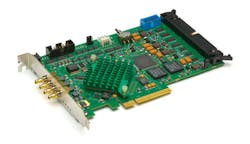Organizations leverage big data for precision medicine
Organizations are teaming up to leverage the cloud and big data to implement precision-medicine technologies to help fight diseases ranging from heart disease to cancer. IBM, for example, has announced an acquisition that will enable its Watson platform to learn from stored medical images. Intel in conjunction with the Oregon Health & Science University (OHSU) has announced a platform-as-a-service (PaaS) solution called the Collaborative Cancer Cloud. And UC San Francisco has received a National Cancer Institute grant of $5 million to lead an effort to integrate data from experimental models across all types of cancer.
Courtesy of IBM
IBM’s initiative—the acquisition of Merge Healthcare announced in August—will give Watson the capability to “see” medical images. “As a proven leader in delivering healthcare solutions for more than 20 years, Merge is a tremendous addition to the Watson Health platform,” said John Kelly, senior vice president, IBM Research and Solutions Portfolio.1 “Healthcare will be one of IBM’s biggest growth areas over the next 10 years, which is why we are making a major investment to drive industry transformation and to facilitate a higher quality of care. Watson’s powerful cognitive and analytic capabilities, coupled with those from Merge and our other major strategic acquisitions, position IBM to partner with healthcare providers, research institutions, biomedical companies, insurers, and other organizations committed to changing the very nature of health and healthcare in the 21st century. Giving Watson ‘eyes’ on medical images unlocks entirely new possibilities for the industry.”
According to Robert McMillan and Elizabeth Dwoskin writing in The Wall Street Journal, “Merge’s crown jewels are 30 billion images, including X-rays, computerized tomography, and magnetic-resonance-imaging scans, that IBM intends to use to ‘train’ its Watson software to identify ailments such as cancer and heart disease.”2
IBM said medical images represent by far the largest and fastest growing data source in the healthcare industry and perhaps the world, with radiologists in some hospital emergency rooms viewing an estimated 100,000 images per day. IBM’s strategy is to combine rich image analytics with deep learning to enable the Watson Health platform to analyze and cross-reference medical images against a trove of lab results, electronic health records, genomic tests, clinical studies, and other data sources.
“As Watson evolves, we are tackling more complex and meaningful problems by constantly evaluating bigger and more challenging data sets,” Kelly said. “Medical images are some of the most complicated data sets imaginable, and there is perhaps no more important area in which researchers can apply machine learning and cognitive computing. That’s the real promise of cognitive computing and its artificial intelligence components—helping to make us healthier and to improve the quality of our lives.”
McMillan and Dwoskin in the Journal noted that training software to produce a diagnosis requires huge numbers of images, with medical-image archiving representing a $3 billion market. One player in this market is startup Enlitic. They quote Enlitic’s CEO, Jeremy Howard, as saying, “People are starting to realize these archives have value. Before, these images were sitting around for 25 years gathering dust.”2
Collaborative Cancer Cloud
Intel announced its Collaborative Cancer Cloud at the Intel Developer’s Forum in August. In a blog post, Eric Dishman, general manager of Intel’s healthcare group, wrote, “Each year millions of people all over the world, including more than 1 million patients in the United States, learn that they have a cancer diagnosis. Instead of going through painful chemotherapy that can kill healthy cells along with cancerous cells, what would happen if those patients were able to be treated as individuals based on their specific genome sequencing, and a precision treatment plan could be tailored specifically for their disease? And what if it could happen within 24 hours?”3
The Collaborative Cancer Cloud is a precision-medicine analytics platform designed to address those questions. Initially, Intel and the Knight Cancer Institute at OHSU will launch the cloud, with additional organizations expected to be onboard in 2016. The cloud will enable institutions to securely share patient genomic, imaging, and clinical data to deliver targeted diagnoses and treatment plans.
Dishman called genomics the first wave of precision medicine, which takes into account differences in people’s genes, lifestyles, and environments. Genomics could yield treatments for diseases including Alzheimer’s, diabetes, and autism as well as cancer.
Explained Dishman, “There have been numerous multi-institution partnerships formed to utilize big data analytics to look for insights about cancer and its treatment. Our focus on the federation/distribution of private datasets is complementary to the exciting work that’s happening to make public data sets more accessible to research.” He added, “In the end, precision medicine will only be as precise as available data allows.”
The cloud initiative is expected to make use of OHSU’s Exacloud, an Intel-provided high-performance computing cluster.
Oncology Models Forum
UC San Francisco will use its National Cancer Institute grant of $5 million over the next five years to lead a massive effort to integrate the data from all experimental models across all types of cancer into a web-based repository. The university said the initiative is an important step in moving the fight against cancer toward precision medicine. The resulting database, called the Oncology Models Forum, will be accessible to researchers through the National Institutes of Health to encourage scientists to use existing validated cancer models rather than creating new ones.
“There are incredible new discoveries happening in cancer research today, such as detecting cancer cells and DNA in the blood stream and even harnessing the immune system to fight cancers,” said Atul Butte, M.D., Ph.D., director of the Institute for Computational Health Sciences at UCSF and principal investigator for the grant, in a press release.4 “These research methodologies generate enormous amounts of data that can and should be harnessed by researchers and engineers to yield new drugs and diagnostics.”
The project aims to create an online cache of molecular data that oncologists and cancer researchers could use to validate the current models that best translate to humans, make predictions about the disease, and move toward a collaborative, precision-medicine approach to cancer. Ultimately, Butte said, the effort also has the potential to create computer-based cancer models that greatly reduce the need for using animals in research.
The project, led by the UCSF Institute for Computational Health Sciences, will involve collaboration with researchers at Stanford University, who will provide support with the latest genetically engineered cancer models as well as standardized nomenclatures. Also participating will be bioinformatics specialists from Northrop Grumman, who will help build and maintain the online database.
References
- Nelson, R., “Planned acquisition to help IBM Watson ‘see’ medical images,” EE-Evaluation Engineering Online, Aug. 12, 2015.
- Mcmillan, R., and Dwoskin, E., “IBM Crafts a Role for Artificial Intelligence in Medicine,” The Wall Street Journal, Aug. 11, 2015.
- Nelson, R., “Intel, OHSU team up on precision-medicine initiative to fight cancer,” EE-Evaluation Engineering
Online, Aug. 24, 2015. - “University helps crunch numbers to combat cancer,” EE-Evaluation Engineering Online, Sept. 15, 2015.
Frame grabbers speed medical-imaging data transfer
Courtesy of BitFlow
Cloud-based medical images represent an invaluable resource. A frame grabber can constitute the first step in getting images to the cloud, and frame-grabber maker BitFlow announced in September that it is leveraging the high-speed CoaXPress interface to bring a new generation of frame grabbers to the $32 billion medical imaging market. The Cyton-CXP, the company reported, delivers Camera Link-type data at GigE-type distances up to 135 meters, achieving rates of 6.25 Gb/s over a single piece of 75-Ω coaxial cable.
In addition, 13 W of power can be transmitted to a camera along the cable, eliminating the need for electrical wiring. Engineers leveraging the Cyton-CXP can repurpose the existing coaxial infrastructure in the imaging system, resulting in lower installation costs, reduced complexity, and improved utilization.
The company said the frame grabber’s compact, low-profile dimensions meet imaging-equipment miniaturization and portability requirements, which are major growth drivers in the medical-imaging market. Cyton-CXP frame grabbers are CoaXPress 1.1-compliant. They support one to four CXP cameras as well as up to four CXP multilinks.
Adding the new Cyton-CXP to a medical imaging application is simplified by the BitFlow SDK (software development kit) that supports both 32-bit and 64-bit operating systems. Imaging applications are developed using C/C++/.NET and BitFlow’s buffer management APIs. In addition, Cyton-CXP models are software-compatible with each other as well as with all the other current BitFlow frame grabbers.
The company said that for more than two decades it has offered frame grabbers to the medical-imaging industry to help acquire high-quality video within the human body for the diagnosis of pathological changes and to precisely target therapeutic procedures. BitFlow frame grabbers are deployed in X-rays, ultrasounds, endoscopes, intraoral cameras, and surgical microscopes to transfer complex, high-resolution color images and video in real time.


